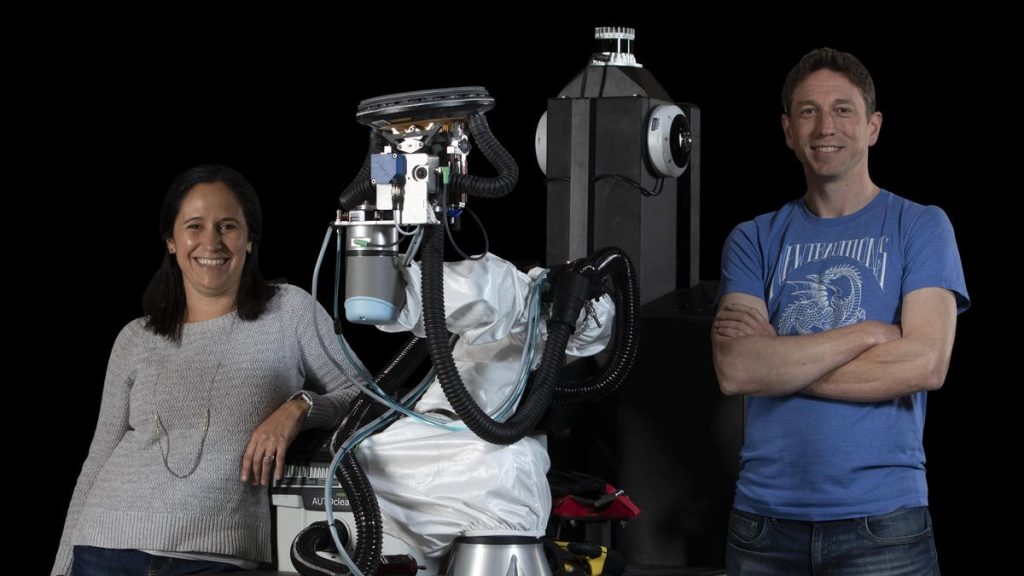Maria Telleria immigrated to America from Mexico as a teenager, earned a Ph.D. at MIT and became a successful entrepreneur. Canvas, the company she cofounded with Kevin Albert, developed a robot that uses AI to increase worker safety and productivity when finishing drywall. “Immigrants have founded or cofounded nearly two-thirds (65% or 28 of 43) of the top AI companies in the United States,” according to a National Foundation for American Policy (NFAP) analysis.
Coming To America
Maria Telleria came to the United States when her father, an engineer and sales executive in the automotive industry, transferred from Mexico to Detroit, Michigan. “I think the biggest challenge was being 14 and being told you have to leave your friends, where you grew up, and switch from a school with 60 in your class to one with 500,” said Maria in an interview. Learning English proved less of a problem because her parents enrolled her as a child in schools with dual language instruction. She also practiced English at Girl Scout summer camps in Texas.
“The biggest culture shift was being uprooted from what you have always known and starting over in a place in the middle of adolescence,” she said. Maria joined the school’s robotics team partly to cope with the changes in her life. The team, which competed nationally, complemented an upbringing in Mexico. As a child, Maria’s father encouraged her to fix things with him around the house. He also arranged tours of manufacturing facilities he visited on sales calls to satisfy her curiosity.
Earning A Ph.D. At MIT
Between Maria’s junior and senior year in high school, she spent six weeks on the MIT campus at a summer program designed to introduce minority students to engineering and entrepreneurship. She enjoyed the hands-on experience, which led her to apply and be accepted to MIT. She admits to being a little scared initially but soon realized her new MIT classmates shared the same anxieties.
Maria earned a bachelor’s degree, a master’s degree and a Ph.D. in mechanical engineering at MIT. Through her research, she saw great possibilities in building robots for situations other than assembly lines at manufacturing plants.
Becoming A U.S. Citizen
While attending MIT, Maria achieved another milestone as an immigrant—she became an American citizen. “We were very lucky,” said Maria. “By that time, I was in Boston, so I went to take the test and do my citizenship with friends rather than family. But it was nice to feel like an adult.”
Maria remembers the experience. The citizenship ceremony to swear her oath was held in Boston’s historic Faneuil Hall. Built in 1742, the hall was the site of debates in Revolutionary America, including meetings leading up to the Boston Tea Party. “I got to become a citizen in a place where America was born,” she said.
An Engineer And Entrepreneur
Near the end of her time at MIT, Maria worked on a project with Kevin Albert at Boston Dynamics. She contacted Kevin and others about her plans to move to California. Kevin told her about a small NASA grant he received to explore designing robots that could operate in places where adapting to the environment would be crucial, such as Mars or underwater. “We worked on grants for a few years until we developed our application and spun out and formed Canvas,” said Maria.
Construction, according to Maria, is an example of an industry that implemented little automation over the past 30 to 40 years. “We had the challenge of an unstructured environment, which robotics didn’t tackle much until recently. That was our passion from the beginning: How can we bring automation to other industries that haven’t benefitted from it?”
Canvas, where Maria is chief technology officer, decided to start with drywall finishing—labor-intensive work that can be dangerous and requires strength and endurance. Maria met many drywall finishers who underwent one or more shoulder surgeries. (Listen to an interview with Maria on the Hazard Girls podcast.) She believes Canvas’s product can prevent repetitive motion injuries. A vacuum attached to the sanding tool helps prevent workers from breathing dust.
The first robot Canvas created was a drywall finishing machine with a robotic arm that telescopes to 16 feet. Using artificial intelligence helps the robot produce consistently high-quality drywall finishes. Utilizing a robot also protects workers from accidental falls and musculoskeletal injuries.
An Innovative Company
At Canvas, Maria says the company focuses on augmenting workers’ skills. She believes too much discussion around AI focuses on replacing workers. She cites how computers have made people more productive, not eliminated the need for workers. With the robotic drywall machine, Canvas shifted the weight-bearing task to the robot and allowed the worker to use their skills.
Canvas has produced 12 systems that it leases to customers around the country. Demand in the Midwest has been strong due to labor shortages. The goal is to spend the next year incorporating customer feedback before making more robotic drywall machines and pursuing global sales.
Maria says being bilingual helps her as CTO. “Construction is an industry that uses a lot of Spanish,” she said. “Much of the labor force has Spanish as a primary language across the United States. Being bilingual has offered an incredible opportunity to talk to our customers, the true users, the operators on the ground. We need them to be engaged and believe in the system, and being able to speak with them in their language, and meet with them and understand their challenges has been crucial.” The company’s robotic interface is in English and Spanish.
What lessons has Maria learned since coming to America as a young immigrant and becoming an entrepreneur? “One of the biggest lessons for me is to use opportunities that exist,” she said. “I never could have had this robotics team in Mexico, where there wasn’t one for me. Instead of sticking only where you’re comfortable, take advantage of company internships or join teams. That is what can put you on an accelerated track. I think sometimes these opportunities are where immigrant communities are underserved or not targeted, so it has to be a little bit on us to search for these chances.” She says for adults, that includes reaching out to people on LinkedIn. “You would be surprised how many people respond, especially if they can see themselves in what you’re doing or going through.”
Maria says she is glad her father and family decided to come to America. “I don’t think I would have had these opportunities if I could not have come to the United States, expand my wings and challenge myself,” said Maria. “I think it helped me grow by being exposed to two cultures. When you have had to think in two different ways, I think it makes you better understand other people and why they’re different. Coming to America has been an amazing opportunity.”
Read the full article here










